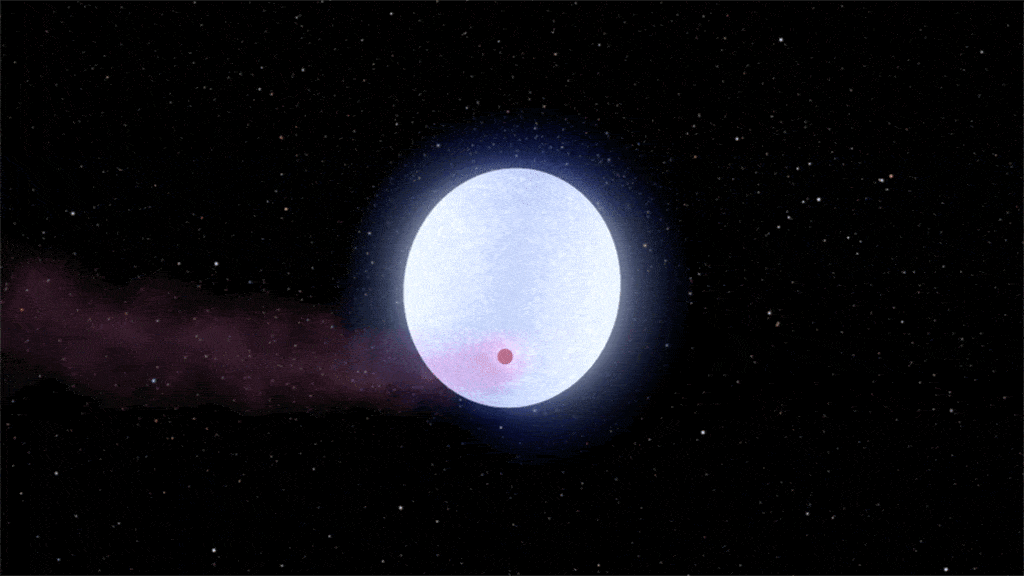In their hunt for alien worlds, astronomers often come across massive gas giants called “hot Jupiters”. These are planets that are at least several times larger than Eart which orbit around their stars far too close to sustain life. In a new study, scientists described such an exoplanet that is so ridiculously hot that even molecules in its atmosphere are torn to shreds.

The ultra-hot Jupiter, known as KELT-9b, is approximately three times more massive than our own Jupiter and orbits star some 670 light-years away.
Astronomers working with NASA’s Spitzer space telescope have found that the planet’s surface can reach a scorching 4,300°C (7,800°F) — that’s hotter than some stars and definitely the hottest planet we’ve ever come across by a large margin.
According to the NASA-affiliated astronomers, the heat is too much to bear even for molecules in the planet’s atmosphere. Writing in their new study, which was published in The Astrophysical Journal, the researchers claim that molecules of hydrogen gas are getting ripped apart on the ultra-hot Jupiter’s dayside.
These atoms eventually reach the planet’s much cooler nightside, which allows the hydrogen gas molecules to reform — but just until they flow back to the dayside, where they repeat the tormenting process over and over again. This process is known as dissociation and recombination and, according to computer models, this is the most likely scenario occurring in KELT-9b’s atmosphere.
As one might expect, KELT-9b’s infernal surface temperature is due to the planet’s very close proximity to its star. The exoplanet completes a full orbit around its star — or a “year” — in only one and a half days.
“This kind of planet is so extreme in temperature, it is a bit separate from a lot of other exoplanets,” said Megan Mansfield, a graduate student at the University of Chicago and lead author of a new paper. “There are some other hot Jupiters and ultra-hot Jupiters that are not quite as hot but still warm enough that this effect should be taking place.”
This incredibly inhospitable planet was first discovered in 2017
by the Kilodegree Extremely Little Telescope (KELT) system—a combined effort involving observations from two robotic telescopes, one in southern Arizona and one in South Africa.
For the new study, the researchers were able to peer through the planet’s atmosphere and measure the temperature of the infernal gas giant using the Spitzer space telescope. Since different halves of the planet rolled into the telescope’s view as the hot Jupiter completed orbits around its star, the researchers were able to discern KELT-9b’s dayside and nightside. Interestingly, the planet is tidally locked, meaning one side permanently faces its star (like our Moon always shows the same face towards Earth). Meanwhile, the nighttime lasts forever.
It’s quite remarkable that we have the technology and know-how allowing us to learn so much about the atmospheres of planets many light-years away. This wouldn’t have been possible, for instance, without the help of the Spitzer space telescope. Alas, this week, NASA will decommission Spitzer after 16 years of service.
Unlike other telescopes such as Hubble or Chandra, which image in the visible light and X-Ray wavelengths, respectively, Spitzer images in the infrared wavelength. At these wavelengths, Spitzer was able to detect objects that are too cold to emit visible light, such as exoplanets and the coldness of the space between stars.
“I’m hoping Spitzer will be remembered as a really amazing scientific gift,” said Sean Carey, the manager of the Spitzer Science Center. “It allowed us to transform our understanding of some very important aspects of astronomy. Spitzer has been integral to that.”
Fortunately, Spitzer has left behind a huge treasure trove of data that will keep astronomers busy making important discoveries for years to come.


